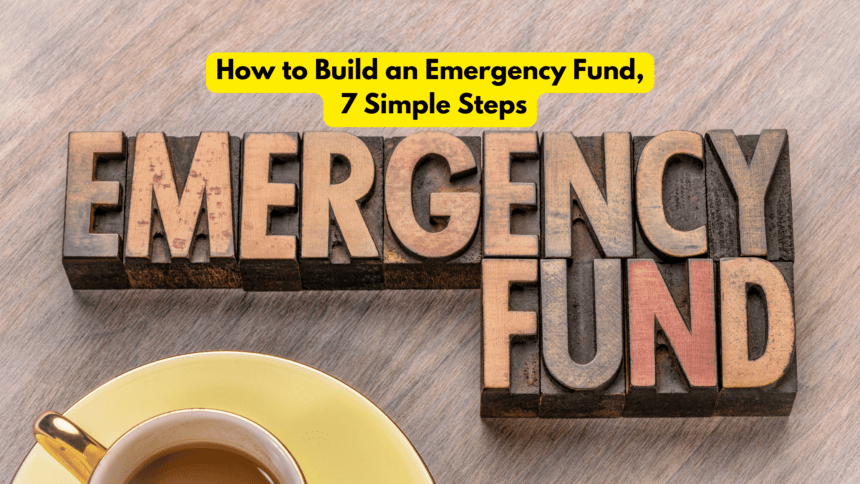Introduction
An emergency fund is your financial safety net, providing peace of mind and security against unforeseen circumstances. Whether it’s an unexpected medical expense, car repair, or job loss, having a dedicated reserve can prevent financial turmoil. This article outlines seven simple steps to help you build a robust emergency fund, ensuring you’re prepared for life’s unpredictabilities.
1. Assess Your Financial Situation
Begin by thoroughly examining your financial landscape. Scrutinize your income streams and list all expenses, from monthly bills to occasional expenditures. This meticulous analysis will reveal potential savings and help you understand your financial habits.
Understanding where your money goes is crucial. It may surprise you to see how much is spent on non-essential items. Identifying these areas allows you to redirect funds towards your emergency savings.
2. Set a Realistic Goal
Determine the appropriate size of your emergency fund by considering your unique circumstances. Financial experts generally recommend saving three to six months’ worth of living expenses. However, your personal situation might necessitate a different amount.
Consider factors like job stability, health conditions, and family responsibilities. A single professional might need less compared to a family with dependents. Setting a realistic, attainable goal is vital for maintaining motivation and ensuring your fund meets your needs.
3. Create a Budget
Develop a comprehensive monthly budget that allocates funds for savings. Begin by listing your income and fixed expenses, such as rent or mortgage, utilities, and groceries. Then, identify discretionary spending areas where you can cut back.
Incorporate a savings category within your budget. Designate a specific amount each month towards your emergency fund. By treating savings as a non-negotiable expense, you can steadily build your fund without feeling the pinch.
4. Reduce Unnecessary Expenses
Trimming non-essential expenditures is a straightforward way to free up funds for your emergency savings. Start by identifying areas where you can cut back. This might include dining out less frequently, cancelling unused subscriptions, or opting for a more economical mobile plan.
Embrace frugality without sacrificing your quality of life. Small changes can lead to significant savings over time. Redirect these savings directly into your emergency fund, accelerating its growth.
5. Automate Your Savings
Automating your savings simplifies the process and ensures consistency. Set up automatic transfers from your checking account to your emergency fund account. This strategy removes the temptation to skip a month and makes saving a seamless part of your financial routine.
Leverage financial tools and apps that facilitate automatic savings. Many banks offer features that round up your purchases and transfer the difference to your savings account. These small, incremental contributions can accumulate over time.
6. Increase Your Income
Enhancing your income can significantly boost your emergency fund. Explore additional income streams such as freelance work, part-time jobs, or monetizing a hobby. Diversifying your income not only speeds up savings but also provides a financial cushion.
Maximize your existing income by seeking raises or promotions at your current job. Take on extra responsibilities or demonstrate exceptional performance to justify a salary increase. Additional income should be directed primarily towards your emergency fund.
7. Monitor and Adjust Your Plan
Regularly review your financial plan to ensure it aligns with your goals. Life circumstances change, and your emergency fund target may need adjustments. Periodic assessments allow you to stay on track and make necessary modifications.
Track your progress and celebrate milestones. Acknowledging your achievements reinforces positive financial habits and motivates you to maintain your saving discipline.
Building Your Emergency Fund Faster
Accelerate your savings by implementing a few strategic measures. Allocate windfalls, such as tax refunds or work bonuses, directly to your emergency fund. Consider temporary austerity measures, like a spending freeze on non-essentials, to boost your savings rate.
Consistency is key. Even small, regular contributions can expedite the growth of your fund. The cumulative effect of disciplined saving habits can surprise you with how quickly your fund grows.
Common Pitfalls to Avoid
Be aware of common mistakes that can derail your savings plan. Avoid dipping into your emergency fund for non-emergencies. Treat it as sacred, only to be used for genuine financial crises.
Resist the urge to set unrealistic goals that lead to frustration and abandonment. Start with attainable targets and gradually increase them as your financial situation improves. Patience and persistence are essential for long-term success.
The Role of Discipline and Patience
Building an emergency fund requires unwavering discipline and patience. Stay committed to your goal, even when progress seems slow. Understanding the long-term benefits can help maintain your motivation.
An emergency fund is not built overnight. It is the result of consistent, deliberate efforts over time. Remind yourself of the security and peace of mind it will provide in the face of unexpected events.
Case Studies: Real-Life Examples
Consider the story of Jane, a single mother who built a six-month emergency fund over two years. By meticulously budgeting, cutting non-essential expenses, and taking on freelance work, she achieved her goal. Her fund provided crucial support when she faced a sudden medical emergency.
Or look at Mark, a young professional who automated his savings and allocated bonuses to his emergency fund. His disciplined approach allowed him to build a substantial reserve within a year, which came in handy during a job transition.
The Psychological Benefits of an Emergency Fund
Beyond financial security, an emergency fund offers significant psychological benefits. It reduces anxiety and stress associated with financial uncertainties. Knowing you have a safety net fosters a sense of control and confidence in managing your finances.
Financial stability enhances overall well-being, allowing you to focus on long-term goals without the constant worry of potential setbacks. The peace of mind that comes with an emergency fund is invaluable.
Long-Term Financial Planning
Integrate your emergency fund savings with broader financial planning. Once your fund is established, redirect savings towards other financial goals such as retirement, education, or investments.
A comprehensive financial strategy ensures that all aspects of your financial life are balanced and aligned. Emergency savings are a crucial component, but they should complement your other financial objectives.
Conclusion
Building an emergency fund is a fundamental step towards financial resilience. By following these seven simple steps, you can create a robust safety net that protects against life’s uncertainties. Start today, stay disciplined, and enjoy the peace of mind that comes with financial preparedness.
For more content follow Humstory.













